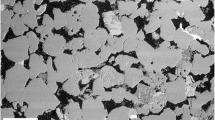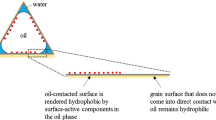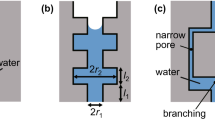Abstract
Hydraulic fracturing causes water to invade reservoir rock. This invaded water is called a water block as it lowers the effective permeability of the rock to oil. Field and laboratory results show that the water block is temporary. We hypothesize that (a) the clearing is caused by capillary-dominated advection of water, and (b) the clearing takes place when the water saturation drops at the fracture face. We test this hypothesis with laboratory experiments, analytic solutions, and numerical simulations to a capillary-driven model. In particular, we determine how the clearing time scales with the permeability of the rock and the amount of water invaded, and this scaling matches experimental observations. From this match, we develop an equation that estimates clearing time and test how the leading coefficient of this equation depends on rock constitutive parameters (e.g., capillary pressure, relative permeability).










Similar content being viewed by others
Availability of data and materials
The data sets collected in this study are available from the corresponding author on request.
Abbreviations
- \(\alpha\) :
-
The scaling coefficient for the water block clearing time, 1 [min/cm] = 3.2*105 (\(\mathrm {min}\sqrt{\mathrm {mD}}/\mathrm {cm}^2\))
- \(\lambda\) :
-
The pore-size-distribution parameter in the pressure-saturation curve, (dimensionless)
- \(\lambda _o\) :
-
The oil mobility, (\(\frac{1}{\mathrm {Pa}\,\mathrm {s}}\))
- \(\lambda _t\) :
-
The total mobility, (\({\frac{1}{\mathrm {Pa}\,\mathrm {s}}}\))
- \(\lambda _w\) :
-
The water mobility, (\({\frac{1}{\mathrm {Pa}\,\mathrm {s}}}\))
- \(\phi\) :
-
The porosity of the rock, (\(\mathrm {m}^3/\mathrm {m}^3\))
- \(\sigma _{ow}\) :
-
The water/oil interfacial tension, (dynes/cm)
- \(\tau\) :
-
The dimensionless temporal variable, (dimensionless)
- \(\tau _w\) :
-
The dimensionless clearing time of the water block, (min/min)
- \(\xi\) :
-
The dimensionless spatial variable, (dimensionless)
- A :
-
The cross-sectional area, (\({\mathrm {cm}^ 2}\))
- \(D^*\) :
-
The dimensionless part of the capillary dispersion term, (dimensionless)
- \(D_0\) :
-
The scaling part of the capillary dispersion term, (\({\mathrm {m}}^2/{\mathrm {s}}\))
- \(f_w\) :
-
The water fractional flow, (\({\frac{\mathrm{m}^3/\mathrm{s}}{\mathrm{m}^3/\mathrm{s}}}\))
- J :
-
The Leverett J-function, (psi/psi)
- \(J_0\) :
-
The coefficient in the Leverett J-function, (psi/psi)
- K :
-
The absolute permeability, (mD)
- \(k_{ro}\) :
-
The relative permeability of oil, (mD/mD)
- \(k_{ro}^{\circ }\) :
-
The end-point relative permeability of oil, (mD/mD)
- \(k_{rw}\) :
-
The relative permeability of water, (mD/mD)
- \(k_{rw}^{\circ }\) :
-
The end-point relative permeability of water, (mD/mD)
- \(L_w\) :
-
The superficial invasion length, (cm)
- \(n_{o}\) :
-
The Corey exponent for oil relative permeability, (dimensionless)
- \(n_{w}\) :
-
The Corey exponent for water relative permeability, (dimensionless)
- \(P_c\) :
-
The water/oil capillary pressure, (psi)
- \(S_w\) :
-
The water saturation, (\({\mathrm {m}^3/\mathrm {m}^3}\))
- \(S_{or}\) :
-
The residual oil saturation, (\({\mathrm {m}^3/\mathrm {m}^3}\))
- \(S_{w0}\) :
-
The initial water saturation, (\({\mathrm {m}^3/\mathrm {m}^3}\))
- \(S_{wj}\) :
-
The average water saturation in the invaded region, (\({\mathrm {m}^3/\mathrm {m}^3}\))
- \(S_{wr}\) :
-
The residual water saturation, (\({\mathrm {m}^3/\mathrm {m}^3}\))
- t :
-
The independent temporal variable, (s)
- \(t_w\) :
-
The clearing time of the water block, (min)
- \(u_t\) :
-
The total volumetric flux, (\(\mathrm {m}^3/\mathrm{s}\))
- \(u_w\) :
-
The water volumetric flux, (\(\mathrm {m}^3/\mathrm{s}\))
- \(V_{inv}\) :
-
The volume of water invasion, (mL)
- x :
-
The independent spatial variable, (cm)
- \(x_{inv}\) :
-
The real water invasion length, (cm)
References
Abrams, A., Vinegar, H.J.: Impairment Mechanisms in Vicksburg Tight Gas Sands. Denver, Colorado, USA, March 1985. Society of Petroleum Engineers. ISBN 978-1-55563-627-2. https://doi.org/10.2118/13883-MS
Ahmadi, M., Sharma, M.M., Pope, G., Torres, D.E., McCulley, C.A., Linnemeyer, H.: Chemical Treatment To Mitigate Condensate and Water Blocking in Gas Wells in Carbonate Reservoirs. SPE Production Oper. 26(01), 67–74, (2011). ISSN 1930-1855. https://doi.org/10.2118/133591-PA
Bennion, D.B., Thomas, F.B., Bietz, R.F.: Low Permeability Gas Reservoirs: Problems, Opportunities and Solutions for Drilling, Completion, Stimulation and Production, (January 1996)
Bennion, D.B., Thomas, F.B.: Formation damage issues impacting the productivity of low permeability, low initial water saturation gas producing formations. J. Energy Resour. Technol., 127, 240–247, (2005). ISSN 0195-0738. https://doi.org/10.1115/1.1937420
Bertoncello, A., Wallace, J., Blyton, C., Honarpour, M.M., Kabir, S.: Imbibition and water blockage in unconventional reservoirs: well-management implications during flowback and early production. SPE Reservoir Evaluat. Eng., 17(04), 497–506, (2014). ISSN 1094-6470. https://doi.org/10.2118/167698-PA
Blunt, M.J.: An empirical model for three-phase relative permeability. SPE J., 5(04), 435–445, (December 2000). ISSN 1086-055X. https://doi.org/10.2118/67950-PA
Blunt, M.J.: Multiphase Flow in Permeable Media: A Pore-Scale Perspective. Cambridge University Press, (February 2017). ISBN 978-1-107-09346-1. Google-Books-ID: kn\_uDQAAQBAJ
Blunt, M.J., Christie, M.A.: Theory of viscous fingering in two phase, three component flow. Soc. Petrol. Eng. (1994). https://doi.org/10.2118/22613-PA
Brooks, R.H., Corey, A.T.: Hydraulic Properties of Porous Media. Fort Collins, Colorado (1964)
Bruce, R.R., Klute, A.: The measurement of soil moisture diffusivity. Soil Sci. Soc. Am. J., 20(4), 458–462, (1956). ISSN 1435-0661. https://doi.org/10.2136/sssaj1956.03615995002000040004x
Buckley, S.E., Leverett, M.C.: Mechanism of fluid displacement in sands. Soc. Petrol. Eng. (1942). https://doi.org/10.2118/942107-G
Calhoun, J.C.. Jr., Lewis, M. Jr., Newman, R.C.: Experiments on the capillary properties of porous solids. J. Petrol. Technol., 1(07), 189–196, (1949). ISSN 0149-2136. https://doi.org/10.2118/949189-G. Publisher: Society of Petroleum Engineers
Chen, X., Kianinejad, A., DiCarlo, D.A.: An extended JBN method of determining unsteady–state two–phase relative permeability. Water Resour. Res., 52, 8374–8383, (2016). ISSN 0043-1397. https://doi.org/10.1002/2016WR019204
Churchwell, L., Radhakrishnan, A., DiCarlo, D.A.: Measurements of three-phase relative permeability as a function of fluid composition. Soc. Petrol. Eng. (2020). ISBN 978-1-61399-705-5. https://doi.org/10.2118/200438-MS
Civan, F.: Reservoir Formation Damage. Gulf Professional Publishing, Houston (2015)
Dawe, R.A., Caruana, A., Grattoni, C.A.: Microscale visual study of end effects at permeability discontinuities. Transp. Porous Media, 86, 601–616, (2011). ISSN 1573-1634. https://doi.org/10.1007/s11242-010-9642-4
Fernandes, BRB, Marcondes, F., Sepehrnoori, K.: Development of a fully implicit approach with intensive variables for compositional reservoir simulation. J. Petrol. Sci. Eng. 169, 317–336, (October 2018). ISSN 0920-4105. https://doi.org/10.1016/j.petrol.2018.05.039
Gdanski, R.D., Fulton, D.D., Shen, C.: Fracture-face-skin evolution during cleanup. SPE Product. Oper., 24(01), 22–34, (February 2009). ISSN 1930-1855. https://doi.org/10.2118/101083-PA. Publisher: Society of Petroleum Engineers
Holditch, S.A.: Factors affecting water blocking and gas flow from hydraulically fractured gas wells. J. Petrol. Technol. (1979). https://doi.org/10.2118/7561-PA
Huang, D.D., Honarpour, M.M.: Capillary end effects in coreflood calculations. J. Petrol. Sci. Eng., 19(1), 103–117, (January 1998). ISSN 0920-4105. https://doi.org/10.1016/S0920-4105(97)00040-5
Kamath, J., Laroche, C.: Laboratory-based evaluation of gas well deliverability loss caused by water blocking. Soc. Petrol. Eng., 8(01), 71–80, (2003). ISSN 1086-055X. https://doi.org/10.2118/83659-PA
Khan, H.J., Mirabolghasemi, M.S., Yang, H., Prodanović, M., DiCarlo, D.A., Balhoff, M.T.: Study of formation damage caused by retention of bi-dispersed particles using combined pore-scale simulations and particle flooding experiments. J. Petrol. Sci. Eng., 158, 293–308, (September 2017). ISSN 0920-4105. https://doi.org/10.1016/j.petrol.2017.08.061. URL http://www.sciencedirect.com/science/article/pii/S0920410517306873
Leverett, M.C.: Capillary behavior in porous solids. Trans. AIME, 142(01), 152–169, (1941). ISSN 0081-1696. https://doi.org/10.2118/941152-G. Publisher: Society of Petroleum Engineers
Liang, T., Longoria, R.A., Lu, J., Nguyen, Q.P., DiCarlo, D.A., Huynh, U.T.: The applicability of surfactants on enhancing the productivity in tight formations. San Antonio, Texas, USA, (2015). Unconventional Resources Technology Conference. ISBN 978-1-61399-433-7. https://doi.org/10.15530/URTEC-2015-2154284
Liang, T., Longoria, R.A., Lu, J., Nguyen, Q.P., DiCarlo, D.A.: Enhancing hydrocarbon permeability after hydraulic fracturing: laboratory evaluations of shut-ins and surfactant additives. SPE J., 22(04), 1,011–1,023, (2017). ISSN 1086-055X. https://doi.org/10.2118/175101-PA
Liang, T., Luo, X., Nguyen, Q.P., DiCarlo, D.A.: Computed-tomography measurements of water block in low-permeability rocks: scaling and remedying production impairment. Soc. Petrol. Eng., 23(03), 762–771, (2018). ISSN 1086-055X. https://doi.org/10.2118/189445-PA
Longoria, R.A., Liang, T., Nguyen, Q.P., DiCarlo, D.A.: When less Flowback is more: a mechanism of permeability damage and its implications on the application of EOR Techniques, (July 2015)
Longoria, R.A., Liang, T., Huynh, U.T., Nguyen, Q.P., DiCarlo, D.A.: Water blocks in tight formations: the role of matrix/fracture interaction in hydrocarbon-permeability reduction and its implications in the use of enhanced oil recovery techniques. Soc. Petrol. Eng. (2017). https://doi.org/10.2118/185962-PA
Luo, X., Nguyen, Q.P., DiCarlo, D.A.: Experimental study on the formation damage caused by gas fracturing fluids. J. Petrol. Sci. Eng., 192(09), 107254–107269, (2020). ISSN 0920-4105. https://doi.org/10.1016/j.petrol.2020.107254
Luo, X., Nguyen, Q.P., DiCarlo, D.A.: The extremum condition of the local volumetric flux for compositional displacements. Transp. Porous Media, 129(3), 941–953, (2019). ISSN 1573-1634. https://doi.org/10.1007/s11242-019-01313-y
Mahadevan, J., Sharma, M.M.: Factors affecting clean-up of water-blocks: a laboratory investigation. Soc. Petrol. Eng., 10(03), 238–246, (2005). ISSN 1086-055X. https://doi.org/10.2118/84216-PA
Mahadevan, J., Sharma, M.M., Yortsos, Y.C.: Evaporative cleanup of water blocks in gas wells. Soc. Petrol. Eng. (2007). https://doi.org/10.2118/94215-PA
McWhorter, D.B., Sunada, D.K.: Exact integral solutions for two-phase flow. Water Resour. Res, 26(3), 399–413, (1990). ISSN 1944-7973. https://doi.org/10.1029/WR026i003p00399
Naik, S., Yang, S., Woolley, M., Bedrikovetsky, P.: Analytical modelling of the water block phenomenon in hydraulically fractured wells. J. Natural Gas Sci. Eng., 67, 56–70, (2019). ISSN 1875-5100. https://doi.org/10.1016/j.jngse.2019.04.018
Richardson, J.G., Kerver, J.K., Hafford, J.A., Osoba, J.S.: Laboratory determination of relative permeability. Soc. Petrol. Eng. (1952). https://doi.org/10.2118/952187-G
Tangirala, S., Sheng, J.J.: Investigation of oil production and Flowback in hydraulically-fractured water-wet formations using the Lab-on-a-Chip method. Fuel, 254, 115543, (2019). ISSN 0016-2361. https://doi.org/10.1016/j.fuel.2019.05.126
Wijaya, N., Sheng, J.J.: Effect of desiccation on shut-in benefits in removing water blockage in tight water-wet cores. Fuel, 24, 314–323, (2019). ISSN 0016-2361. https://doi.org/10.1016/j.fuel.2019.01.180
Wijaya, N., Sheng, J.J.: Shut-in effect in removing water blockage in shale-oil reservoirs with stress-dependent permeability considered. SPE Reservoir Evaluat. Eng., 23(01), 81–94, (2020). ISSN 1094-6470. https://doi.org/10.2118/195696-PA. Publisher: Society of Petroleum Engineers
Zhou, D., Jia, L., Kamath, J., Kovscek, A.R.: Scaling of counter-current imbibition processes in low-permeability porous media. J. Petrol. Sci. Eng., 33(1), 61–74, April 2002. ISSN 0920-4105. https://doi.org/10.1016/S0920-4105(01)00176-0. URL http://www.sciencedirect.com/science/article/pii/S0920410501001760
Funding
This work was funded by Equinor Gulf of Mexico LLC through the Equinor Fellowship Program at The University of Texas at Austin. We would also like to acknowledge the support from the Shell-UT Unconventional Research (SUTUR) and Foundation CMG.
Author information
Authors and Affiliations
Contributions
XL contributed to conceptualization, methodology, investigation, writing original draft, visualization. QN contributed to resources, supervision, writing—review and editing, funding acquisition. DD contributed to resources, writing—review and editing, supervision, funding acquisition.
Corresponding author
Ethics declarations
Conflict of interest
All authors declare they have no conflict of interests.
Code availability
Not applicable
Additional information
Publisher's Note
Springer Nature remains neutral with regard to jurisdictional claims in published maps and institutional affiliations.
Rights and permissions
About this article
Cite this article
Luo, X., Nguyen, Q. & DiCarlo, D. A Simple Scaling Approach to the Spontaneous Clearing Time of Water Block. Transp Porous Med 137, 1–19 (2021). https://doi.org/10.1007/s11242-020-01529-3
Received:
Accepted:
Published:
Issue Date:
DOI: https://doi.org/10.1007/s11242-020-01529-3




